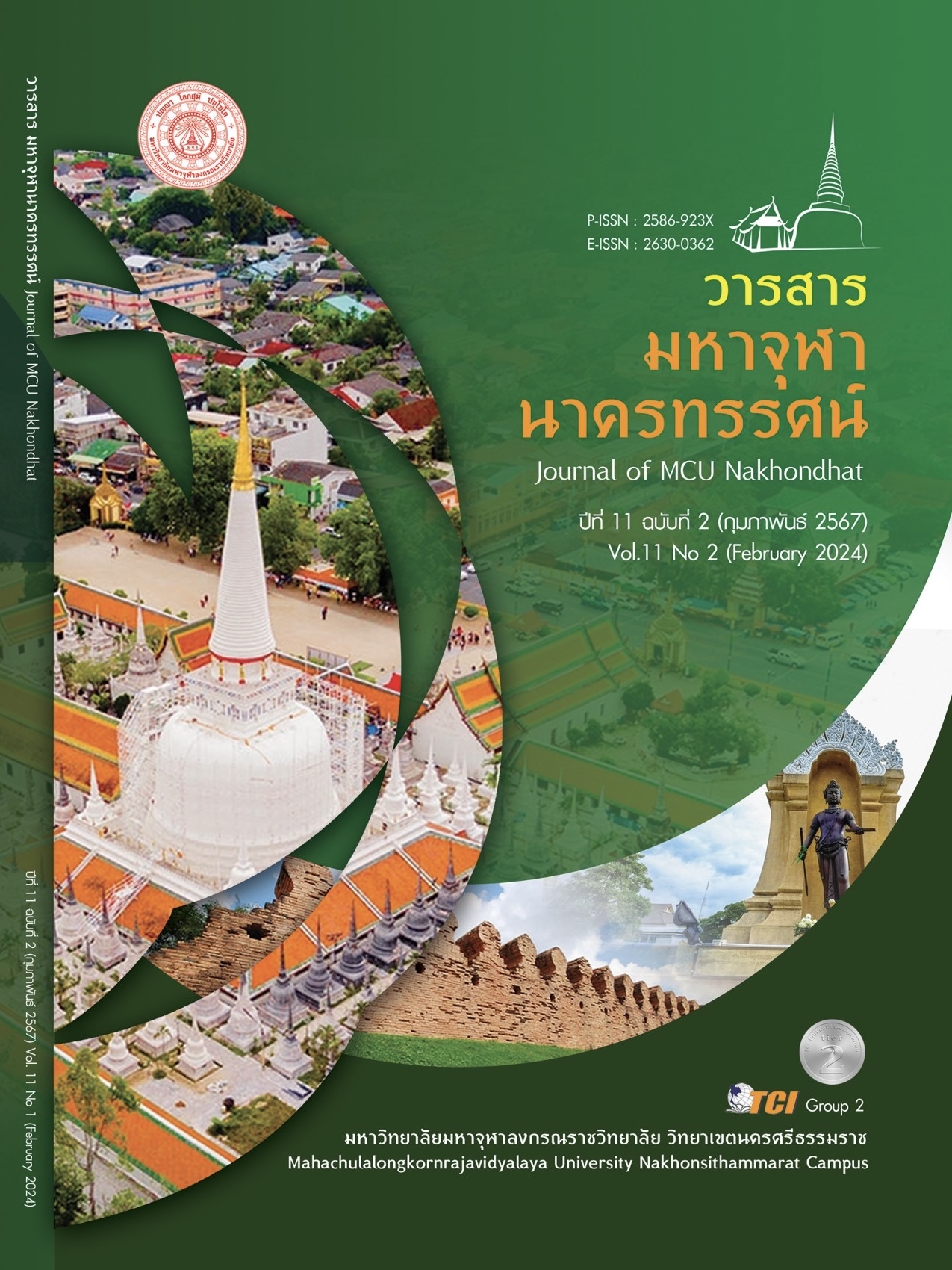ผลการจัดการเรียนรู้โดยใช้วัฏจักรการเรียนรู้ 7 ขั้น ที่มีต่อผลสัมฤทธิ์ทาง การเรียนรายวิชาวิทยาศาสตร์ สำหรับนักเรียนประถมศึกษาปีที่ 6 โรงเรียนซางตาครู้สคอนแวนท์
Main Article Content
บทคัดย่อ
การวิจัยครั้งนี้มีวัตถุประสงค์เพื่อ 1) เปรียบเทียบผลการจัดการเรียนรู้โดยใช้วัฏจักรการเรียนรู้ 7 ขั้นที่มีต่อผลสัมฤทธิ์ทางการเรียนรายวิชาวิทยาศาสตร์ สำหรับนักเรียนประถมศึกษาปีที่ 6 โรงเรียนซางตาครู้สคอนแวนท์ 2) เพื่อศึกษาความพึงพอใจของนักเรียนประถมศึกษาปีที่ 6 โรงเรียนซางตาครู้สคอนแวนท์ ในการจัดการเรียนรู้โดยใช้วัฏจักรการเรียนรู้ 7 ขั้น เป็นการวิจัยแบบผสมผสาน กลุ่มตัวอย่างที่ใช้ในการวิจัยเป็นนักเรียนโรงเรียนซางตาครู้สคอนแวนท์ ชั้นประถมศึกษาปีที่ 6/1 จำนวน 29 คน ได้มาโดยใช้วิธีการสุ่มอย่างง่าย โดยใช้ห้องเรียนเป็นหน่วยสุ่ม เครื่องมีอที่ใช้ในการวิจัยประกอบด้วย 1) แผนการจัดการเรียนรู้2) แบบทดสอบ และ 3) แบบสอบถาม สถิติที่ใช้ในการวิจัย ได้แก่ค่าเฉลี่ย (Mean) ส่วนเบี่ยงเบนมาตรฐาน (ค่า t - test for Dependen) ผลการวิจัยพบว่า 1) ผลสัมฤทธิ์ทางการเรียนรายวิชาวิทยาศาสตร์ ของนักเรียนประถมศึกษาปีที่ 6 โดยใช้วัฏจักรการเรียนรู้ 7 ขั้น หลังเรียนสูงกว่าก่อนเรียนอย่างมีนัยสำคัญทางสถิติที่ระดับ .05 2) ความพึงพอใจของนักเรียนชั้นประถมศึกษาปีที่ 6 โรงเรียนซางตาครู้สคอนแวนท์ ที่มีต่อการเรียนโดยใช้วัฏจักรการเรียนรู้ 7 ขั้น โดยรวมอยู่ในระดับมากที่สุดจากการเรียนการสอนดังกล่าวมีเป้าหมายที่สำคัญ คือ การพัฒนาผู้เรียนให้ผู้เรียนมีความสมบูรณ์ในการเรียนการสอนโดยพัฒนาผู้เรียนให้เป็นไปตามเป้าหมายที่เรากำหนดขึ้น คือ กระบวนการจัดการเรียนการสอน 7 ขั้น จะครอบคลุมในส่วนของการพัฒนาผู้เรียนทางด้านของความรู้การประยุกต์ความรู้ไปสู่ในเรื่องของการสร้างสรรค์นวัตกรรมและการจัดการความรู้ให้มีศักยภาพและสามารถนำเอาความรู้ไปใช้ในการต่อยอดและสร้างสรรค์สังคมได้อย่างมีคุณภาพ
Article Details

อนุญาตภายใต้เงื่อนไข Creative Commons Attribution-NonCommercial-NoDerivatives 4.0 International License.
เอกสารอ้างอิง
กมลวรรณ ทับโต. (2561). การจัดการเรียนรู้แบบวัฏจักรสืบเสาะหาความรู้ 7E เพื่อพัฒนาทักษะการคิด วิเคราะห์ในวิชาวิทยาศาสตร์ สำหรับนักเรียนชั้นประถมศึกษาปีที่ 3. ใน วิทยานิพนธ์การศึกษามหาบัณฑิต สาขา วิชาการพัฒนาหลักสูตรและนวัตกรรมการสอน. มหาวิทยาลัยเทคโนโลยีราชมงคลธัญบุรี.
กระทรวงศึกษาธิการ. (2553). หลักสูตรแกนกลางการศึกษาขั้นพื้นฐาน พุทธศักราช 2551 พิมพ์ครั้งที่ 3. กรุงเทพมหานคร: โรงพิมพ์ชุมนุม สหกรณ์การเกษตรแห่งประเทศไทย.จำกัด.
กระทรวงศึกษาธิการ. (2560). ตัวชี้วัดและสาระการเรียนรู้แกนกลาง กลุ่มสาระการเรียนรู้วิทยาศาสตร์ (ฉบับปรังปรุง พ.ศ. 2560) ตามหลักสูตรแกนกลางการศึกษาขั้นพื้นฐาน พ.ศ. 2551. กรุงเทพมหานคร: โรงพิมพ์ชุมนุมสหกรณ์กาเกษตรแห่งประเทศไทย.
จรัญ น่วมมะโน. (2560). การพัฒนารูปแบบการนิเทศภายในเพื่อพัฒนาสมรรถนะครูในการจัดการเรียนรู้ภาษาอังกฤษสำหรับโรงเรียนมัธยมศึกษาในภาคตะวันออกเฉียงเหนือ. ใน วิทยานิพนธ์ การศึกษาดุษฎีบัณฑิต สาขาวิชาการนิเทศการศึกษา. มหาวิทยาลัยมหาสารคาม.
พัทธมน วิริยะธรรม. (2559). การพัฒนาผลสัมฤทธิ์ทางการเรียนและความสามารถในการแก้โจทย์ปัญหาเรื่องปริมาณสารสัมพันธ์ของนักเรียนชั้นมัธยมศึกษาปีที่4 โดยใช้รูปแบบการสอนแบบวัฏจักรการเรียนรู้ 7E ร่วมกับเทคนิค KWDL. ใน วิทยานิพนธ์มหาบัณฑิต สาขาวิชาการสอนวิทยาศาสตร์ . มหาวิทยาลัยบูรพา.
มาเรียม นิลพันธุ์ และคณะ. (2555). การพัฒนานวัตกรรมการจัดการเรียนการสอนที่เน้นความแตกต่างระหว่างบุคคล. วารสารมหาวิทยาลัยศิลปากร ฉบับภาษาไทย, 33(2), 83-105.
ศศิธร คล้อยแสงอาทิตย์. (2565). การพัฒนาหลักสูตรออนไลน์เพื่อเสริมสร้างสมรรถนะการจัดการเรียนรู้ภาษาอังกฤษสำหรับครูที่มีวุฒิไม่ตรงสาขา ระดัประถมศึกษา. ใน วิทยานิพนธ์มหาบัณฑิต สาขาการสอนวิทยาศาสตร์ . มหาวิทยาลัยศรีนครินทรวิโรฒ.
Eisenkraft, A. (2003). Expanding the 5E Model: A Proposed 7E Model Emphasizes Transferring Learning and the Importance of Eliciting Prior Understanding. The Science Teacher, 70(6), 56-59.
Yager, R. E. (1991). The Constructivist learning model. The Science Teacher, 58(6), 52-57.


